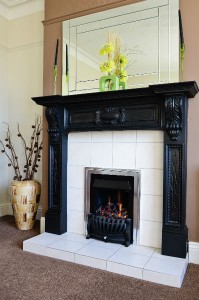Pros and Cons of a Gas Fireplace
The popularity of gas fireplaces is only continuing to grow — according to the Hearth, Patio & Barbecue Association, which represents the hearth products industry, nearly 70 percent of the hearth products used today use natural gas or propane as a fuel.
The ease of using gas fireplaces and logs plays no small role in that popularity — instead of chopping and stacking wood, painstakingly building fires and scooping up ash, homeowners are pressing a button and enjoying a warm, mood-enhancing fire. Convenience isn’t the only benefit you get with a gas fireplace, though — these units can provide consistent, efficient and cleaner heat, and you can have far broader installation options, too.
Choosing between fuels is a personal choice, and gas might not be the ideal choice for you. If you’re trying to decide whether a gas fireplace makes sense for your home, here’s a little more info that might spark a decision.
Gas Fireplace Pros
Push-button warmth and ambience
You can’t oversell the convenience of gas fireplaces — and as busy as we all are these days, between careers, home and family, the minimized work plays a big role in many homeowners’ choice. But it goes beyond the ease of starting and maintaining an enjoyable fire — manufacturers have added plenty of other figurative bells and whistles to modern units, including remote controls, timers that turn the fireplace off so you can fall asleep to a warm fire, blowers and fans that circulate more heat through the room and thermostats that keep that heat consistent.
Realistic fires
True, you’re not stacking up logs for flames to curl around, but that doesn’t mean your fireplace won’t look like you have been. Ceramic refractory gas logs have come a long way — many are hand-made and hand-painted to look incredibly realistic, from knots and bark to glowing embers. You could choose deep, charred logs, light beach wood — sacrificing aesthetics for function is definitely a thing of the past.
Broader installation options
There are multiple considerations when you’re installing a masonry wood-burning fireplace, from the chimney to the concrete footing that holds it up. Pre-fabricated gas fireplaces can offer more flexibility. Zero clearance units are constructed so that minimal space is needed between the fireplace and surrounding combustible materials. Vent-free units don’t even need a traditional chimney. Chimney professionals can help you understand the options that might work best with your needs and the room you’re hoping to add a fireplace to.
Gas Fireplace Cons
You have to buy fuel
Homeowners in wooded areas often use fallen timber, cut and dried thoroughly, to fuel their wood-burning fireplaces for free. With a gas fireplace, you don’t get option.
If you love the smell of burning wood, you’ll miss it
It’s a personal preference: Some homeowners can’t get enough of that smoky, oaky smell that comes with a wood-burning fireplace; others hate it. (Still others find that wood fire byproducts flare up asthma and other health issues.) If you’re in the love camp, you’ll miss that smell, with a gas-burning fireplace. But then, they do make wood fire-scented candles these days, too.
Whether you’re a fireplace lover looking for heat or ambiance, convenience or aesthetic, there are options out there that meet your needs. And once you’re settled on what you really want, chimney and fireplace professionals can help you find the perfect fireplace.

